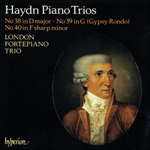‘Tomes and her partners identify themselves fully with the emotional scale of the works … there is so much from the Florestan to stop us in our tracks … a very special disc, recorded in detailed, front-row sound’ (Gramophone)
‘These are altogether lively and alert performances, with repeats imaginatively varied, and a real feel for the subtle balance of the music’ (BBC Music Magazine)
‘Four of Haydn's later trios, including the familiar 'Gypsy Rondo', are played here by the Florestan Trio with a captivating grace’ (The Observer)
‘The articulation of Susan Tomes and her colleagues is alert and imaginative, with a 'period-instrument' feel for texture, effortlessly capturing Haydn's mercurial wit’ (The Sunday Times)
‘The Florestan is the ultimate in gentility and grace … the playing, interpretation, and recorded sound are perfection; every note, every phrase, every balance is beyond criticism’ (Fanfare, USA)
‘It is a pleasure to hear the Florestans strike their expected and convincing balance. They are a Haydnesque ensemble in the very best sense’ (NewClassics.com)
‘It would be hard to find crisper performances of Haydn's piano trios. The Florestan Trio is not a period instrument ensemble, but it never makes us wish it were, for these musicians don't play Haydn as if it were Beethoven or Schubert. The interpretations are articulate, stylish and vivid; accents spit and tingle; and passagework whizzes sharp and serrated as a saw blade. They take risks: some fast movements move at blistering speeds, and the exaggerated upbeats and shifts in tempo make their free-wheeling Gypsy Rondo sound like the real thing. Slow movements sing, and the balance—so crucial in these trios—is heavenly’ (The Globe and Mail, Canada)
‘This first volume in a projected series of the complete Haydn piano trios promises many future delights. The performances are, by and large, excellent … kudos particularly are in order for pianist Susan Tomes. These are keyboard works first and foremost, and she leads with great sensitivity and elegance’ (Classics Today)
‘What comes through vividly here is Haydn’s capacity to surprise; and the discovery of the music is in listening to them. Suffice it to say that the music’s essential grace, lightness and sparkle is affectionately captured by the members of The Florestan Trio, who are also alive to the musical and emotional diversions that Haydn imaginatively and wittily incorporates … with excellent recorded sound and an illuminating booklet note by Robert Philip, this release offers much joy’ (Classical Source)


 Haydn: Piano Trios Nos 38-40
Haydn: Piano Trios Nos 38-40
